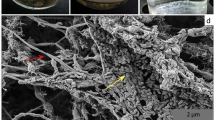Abstract
Natural relationships, improvement of anaerobic growth on hydrocarbons, and properties that may provide clues to an understanding of oxygen-independent alkane metabolism were studied with two mesophilic sulfate-reducing bacteria, strains Hxd3 and Pnd3. Strain Hxd3 had been formerly isolated from an oil tank; strain Pnd3 was isolated from marine sediment. Strains Hxd3 and Pnd3 grew under strictly anoxic conditions on n-alkanes in the range of C12–C20 and C14–C17, respectively, reducing sulfate to sulfide. Both strains shared 90% 16 S rRNA sequence similarity and clustered with classified species of completely oxidizing, sulfate-reducing bacteria within the δ-subclass of Proteobacteria. Anaerobic growth on alkanes was stimulated by α-cyclodextrin, which served as a non-degradable carrier for the hydrophobic substrate. Cells of strain Hxd3 grown on hydrocarbons and α-cyclodextrin were used to study the composition of cellular fatty acids and in vivo activities. When strain Hxd3 was grown on hexadecane (C16H34), cellular fatty acids with C-odd chains were dominant. Vice versa, cultures grown on heptadecane (C17H36) contained mainly fatty acids with C-even chains. In contrast, during growth on 1-alkenes or fatty acids, a C-even substrate yielded C-even fatty acids, and a C-odd substrate yielded C-odd fatty acids. These results suggest that anaerobic degradation of alkanes by strain Hxd3 does not occur via a desaturation to the corresponding 1-alkenes, a hypothetical reaction formerly discussed in the literature. Rather an alteration of the carbon chain by a C-odd carbon unit is likely to occur during activation; one hypothetical reaction is a terminal addition of a C1 unit. In contrast, fatty acid analyses of strain Pnd3 after growth on alkanes did not indicate an alteration of the carbon chain by a C-odd carbon unit, suggesting that the initial reaction differed from that in strain Hxd3. When hexadecane-grown cells of strain Hxd3 were resuspended in medium with 1-hexadecene, an adaptation period of 2 days was observed. Also this result is not in favor of an anaerobic alkane degradation via the corresponding 1-alkene.
Similar content being viewed by others
Author information
Authors and Affiliations
Additional information
Received: 25 June 1998 / Accepted: 29 July 1998
Rights and permissions
About this article
Cite this article
Aeckersberg, F., Rainey, F. & Widdel, F. Growth, natural relationships, cellular fatty acids and metabolic adaptation of sulfate-reducing bacteria that utilize long-chain alkanes under anoxic conditions. Arch Microbiol 170, 361–369 (1998). https://doi.org/10.1007/s002030050654
Issue Date:
DOI: https://doi.org/10.1007/s002030050654




